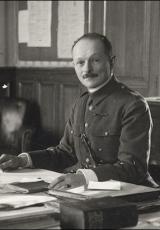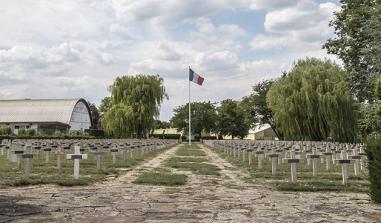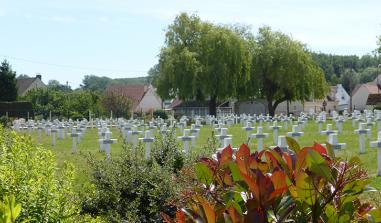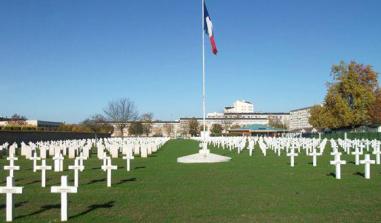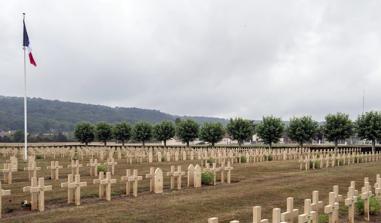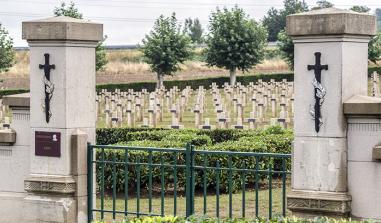The Cambronne-lès-Ribécourt national cemetery
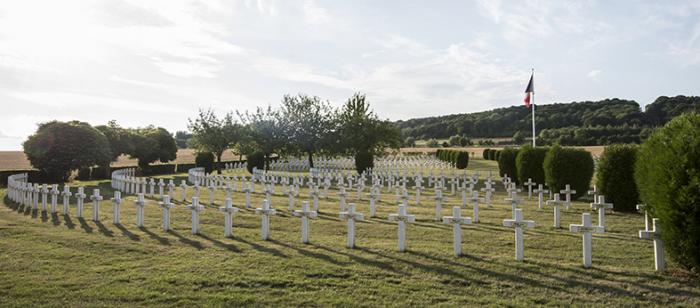
La nécropole nationale de Cambronne-lès-Ribécourt. © ECPAD
Pour accéder au panneau d'information de la nécropole, cliquer ici 
Created in 1950, the Cambronne-lès-Ribécourt national cemetery is a combined cemetery, for on that date the remains of French soldiers who had died for their country during the French campaign (May-June 1940) and during the fighting for national liberation (1944-1945) were brought together. As a result of the Second World War, there are 2,106 soldiers and resistance fighters, as well as three Poles, a Spaniard and a Romanian.
This site was developed from 1972 to 1974 in order to welcome the mortal remains of 126 soldiers from the Great War. All of the bodies - including those from the Great War - were exhumed in the Eure, Oise, Somme and Seine-Maritime departments. The layout of this site thus reflects its history, since the 1939-1945 graves are set out in a semi-circle at the entrance, whilst those from 1914-1918 are aligned at the rear of the cemetery.
Among the 2,237 soldiers who lie here are the bodies of Major Bouquet, Captain Speckel and the infantrymen Lena Faya and Aka Tano, who were summarily executed in June 1940 in the Bois d'Eraines. The remains of the liner Meknès were also brought to the Cambronne-lès-Ribécourt cemetery. On 24 July 1940 this ship was torpedoed at sea, leaving 430 dead - including Christian Werno.
La nécropole nationale de Cambronne-lès-Ribécourt. © Guillaume Pichard
La nécropole nationale de Cambronne-lès-Ribécourt. © Guillaume Pichard
La nécropole nationale de Cambronne-lès-Ribécourt. © Guillaume Pichard
La nécropole nationale de Cambronne-lès-Ribécourt. © Guillaume Pichard
La nécropole nationale de Cambronne-lès-Ribécourt. © Guillaume Pichard
La nécropole nationale de Cambronne-lès-Ribécourt. © Guillaume Pichard

Le général Weygand, chef d'état-major de la défense nationale et commandant en chef (à partir du 20 mai 1940) sortant du bastion 32, PC de l’amiral Abrial, mai 1940, Dunkerque (Nord). © ECPAD

Entrée de l’armée allemande à Compiègne, 1940. © ECPAD/collection Capron

Prisonniers de guerre nord-africains, 1940. © ECPAD/collection Capron

Camp de prisonniers français réservé aux troupes coloniales, mai 1940. © ECPAD/Fonds allemand

Exode de réfugiés français fuyant les combats sur Dunkerque lors de l’opération Dynamo à Dunkerque, mai 1940. © ECPAD/Jean-Paul Lavergne/collection Massberg

Défilé de l'armée allemande sur les Champs-Elysées, juin 1940. Deux jours après l’entrée des premières troupes allemandes de la 9.Infanterie-Division à Paris, la "Parade de la victoire" se déploie entre la place de l’Étoile, la place de la Concorde puis l’avenue Foch où la 30.Infanterie-Division est saluée par le général Kurt von Briesen.© ECPAD/Fonds allemand

La légion étrangère en mouvement sur la route de Villiers-sur-Loudun, à proximité d’Elincourt-Sainte-Marguerite, après avoir été relevée du secteur de Cambronne-lès-Ribécourt, 1916. © BDIC

Troupes françaises en position sur le Mont-Renaud, août 1918. À 2 km au sud-ouest de Noyon, le Mont-Renaud, près de Passel, est un lieu de combats perpétuels pendant la guerre. Le matin du 29 août 1918, la 3e armée reprend définitivement ce lieu stratégique.© ECPAD/Jacques Ridel
Practical information
Cambronne-lès-Ribécourt
Au nord de Compiègne, N 32
Visites libres toute l’année
Read more
Read more
Comité départemental du Tourisme de l'Oise
Rue du Pont de Paris
60008 Beauvais Cedex
Tél. : 03 44 45 82 12


